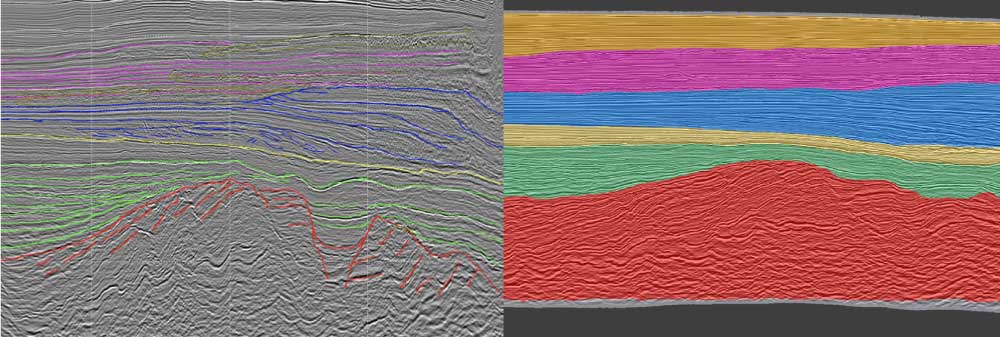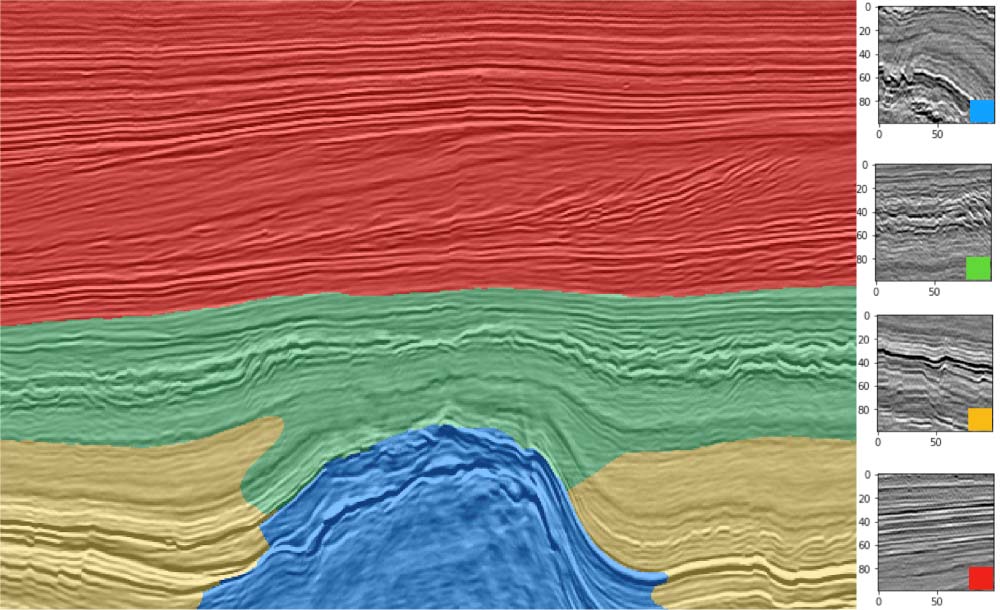CHALLENGE:
- Interpreting seismic volumes takes an inordinate amount of time by a high-value expert resource
- Confidence in and repeatability of the results is tenuous
SOLUTION:
- Machine learning techniques automatically and reliably delineate measured patterns for the interpreter
- Designed to require minimal input from the interpreter and follow familiar processing methods
RESULTS:
- Efficiency increased by 1-2 orders of magnitude
- Confidence in results increased
- Expert resources freed from tedious, low-value tasks to focus on quality and value
- Interpreter now only has to interpret less than 1:1000 cross-sections instead of previous 1:10
Determine if AI and machine learning techniques can be used to more efficiently analyze seismic volumes
Seismic is the first field measurement in the oil exploration process. Offshore, hundreds of square miles can be covered in single survey, generating terabytes of data. Petroleum geophysicists must analyze this volume of data to identify potential hydrocarbon reservoirs.
In seismic surveys, an energy source at surface creates elastic waves that go into the Earth, where each different layer reflects a portion of the wave energy back to surface, where it is measured. The rest goes through to interact with deeper layers and reflect in the same way.
The challenge is to increase efficiency in handling, integrating, and analyzing data at every opportunity, freeing experts for analysis. Today this includes applying the latest machine learning techniques, which can both increase efficiency and increase chances of exploration success.
In partnership with a major independent, Enthought conducted R&D into the efficacy of using machine learning techniques and custom processing workflows to automatically delineate measured patterns throughout a seismic volume.
Compare manual sequenced stratigraphy with AI workflows
Basic stratigraphic units within seismic volumes which can contain hydrocarbons are defined by careful analysis by a skilled sequence stratigrapher. These patterns may be defined objectively and are considered to be predictable.1
Machine learning and AI can alleviate the drudgery of interpreting large seismic volumes and allow more time for experts to focus on quality and value. Our approach was designed to operate with minimal input from the interpreter. Where possible, we limited the complexity of machine learning systems, and applied standard seismic processing methods familiar to the interpreter, while taking significantly less time.
AI assisted model shows a high degree of consistency with expert interpreter’s findings
In a typical workflow, the sequence stratigrapher would interpret a seismic volume by analyzing a sequence of 2D cross-sections sampled regularly throughout. This typically involves interpreting 1 in every 10 or more of the possible cross sections to produce a consistent volume, an arduous and labor intensive process. In this proof of concept project using AI, the interpreter had only to interpret less than 1 in every 1000 possible cross-sections from the Poseidon data, training a machine, which then interpreted the remaining volume.
This approach is shown in two examples in these figures:
Figure 1. The first is where a sequence stratigrapher provides a manual interpretation of an inline taken from the Poseidon seismic volume.2 Learning from the manual interpretation, a set of stratigraphic units are then automatically identified by the system some distance away from the initial interpretation.

The schematic on the left shows an interpretation applied to an inline within the Poseidon seismic volume. The colored image demonstrates corresponding interpretation made by the automated system some distance from this initial interpretation. There is a high degree of consistency in what can be seen to be similar features.

Figure 2. In the second example, the algorithm is trained using a library of seismic facies. This data was taken from the LANDMASS-1 dataset.3 The set of labeled seismic facies consists of salt, faulted and chaotic areas, and regular horizons. Learning from the LANDMASS-1 examples, facies are then predicted across the F3 seismic volume.4
In the video below, Ben Lasscock, Energy Solutions Group Technical Lead at Enthought, discusses a deep learning tool created by Enthought to automate the interpretation of sequence stratigraphy.
References
1Seismic Stratigraphy and Global Changes of Sea Level, Part 6: Stratigraphic Interpretation of Seismic Reflection Patterns in Depositional Sequences, R. M. Mitchum et al, AAPG Special Volumes, 1977
3LANDMASS, Large North-Sea dataset of migrated aggregated seismic structures